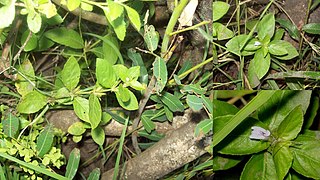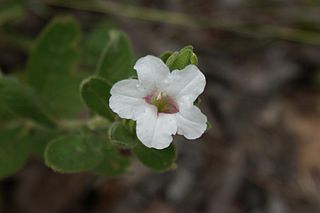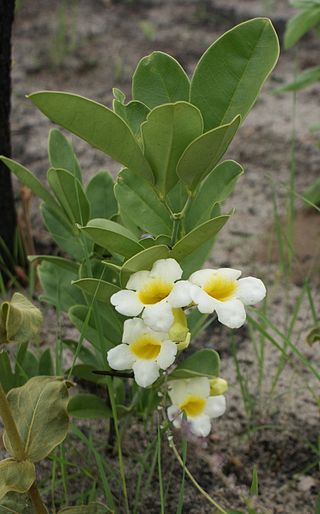
Carl Friedrich Philipp von Martius was a German botanist and explorer. Between 1817 and 1820, he travelled 10,000 km through Brazil while collecting botanical specimens. His most important work was a comprehensive flora of Brazil, Flora Brasiliensis, which he initiated in 1840 and was completed posthumously in 1906.
Justicia triloba is a species of flowering plant in the family Acanthaceae. It a shrub native to the Caatinga vegetation and Cerrado vegetation of Brazil, ranging from Tocantins to Piauí and Minas Gerais states.
Ruellia verbasciformis is a species of flowering plant native to the Cerrado vegetation of Brazil. It is endemic to west-central Brazil. This plant is cited in Flora Brasiliensis by Carl Friedrich Philipp von Martius.

Hygrophila costata, with the common names glush weed, gulf swampweed, and yerba de hicotea, is an aquatic plant.
Stenandrium pohlii, with Portuguese common names caiapiá or carapiá, is a species of flowering plant in the family Acanthaceae. It is a perennial native to Bolivia, Paraguay, and western, southeastern, and southern Brazil. It is native to Cerrado and Pantanal ecoregions of Brazil. The description of the plant was published in Flora Brasiliensis in 1847.

Ruellia nitens is a species of flowering plant native to the Cerrado vegetation of central and northeastern Brazil. This plant is cited in Flora Brasiliensis by Carl Friedrich Philipp von Martius.

Astronium fraxinifolium is a timber tree, which is native to Amazon Rainforest, Atlantic Forest, Caatinga, and Cerrado vegetation in Brazil. Common names include kingwood, locustwood, tigerwood, and zebrawood. It is known in Portuguese as Gonçalo-alves. This plant is cited in Flora Brasiliensis by Carl Friedrich Philipp von Martius. It is also used to make hardwood such as tigerwood.

Astronium graveolens is a species of flowering tree in the cashew family, Anacardiaceae, that is native to Mexico, Central America, and South America as far south as Bolivia. Common names include glassywood, ronrón (Spanish), and aroeira (Portuguese). This plant is cited in Flora Brasiliensis by Carl Friedrich Philipp von Martius.

Aspidosperma cylindrocarpon is a timber tree native to Brazil, Paraguay, Bolivia, and Peru. It is common in Atlantic Forest, Cerrado and Pantanal vegetation of Brazil. This plant is cited in Flora Brasiliensis by Carl Friedrich Philipp von Martius. In addition, it is useful for beekeeping.

Aspidosperma parvifolium is a timber tree native to Brazil, which is typical of Atlantic Forest, Cerrado, Caatinga, and Pantanal vegetation. This plant is cited in Flora Brasiliensis by Carl Friedrich Philipp von Martius. In addition, it is useful for beekeeping.
Allamanda puberula is a species of plant in the family Apocynaceae, which is native to Brazil, typically in Caatinga, and Cerrado vegetation. This plant is cited in Flora Brasiliensis by Carl Friedrich Philipp von Martius.

Aristolochia gigantea, the Brazilian Dutchman's pipe or giant pelican flower, is an ornamental plant native to Brazil, Costa Rica and Panama. Typical of subtropical Bahia and Minas Gerais vegetation, it is a vigorous evergreen climber (vine) with heart-shaped leaves and spectacular fragrant flowers. This plant is cited in Flora Brasiliensis by Carl Friedrich Philipp von Martius. A. gigantea and other tropical Dutchman's pipe varieties pose a threat to the pipevine swallowtail butterfly. The butterfly confuses A. gigantea with its native host plant and will lay eggs on it although pipevine swallowtail caterpillars cannot survive on the foliage because the leaves are toxic to the larvae.

Leopoldinia piassaba, the Para piassava, piassava fiber palm or piassava palm, is a palm native to black water rivers in Amazonian Brazil and Venezuela, from which is extracted piassava, a high caliber and water resistant fiber. Piassaba fiber is made into brooms, baskets and other products. This plant is also a natural habitat of the Rhodnius brethesi which is a potential vector of Chagas disease and it is cited in Flora Brasiliensis by Carl Friedrich Philipp von Martius.

Anemopaegma glaucum is a plant native to Caatinga and Cerrado vegetation in Brazil. This plant is cited in Flora Brasiliensis by Carl Friedrich Philipp von Martius.

Senecio brasiliensis, known by the common name flor-das-almas, (flower-of-souls), is a perennial species of the genus Senecio and family Asteraceae. It is native to fields and meadows of central South America.
Wittmackia brasiliensis is a species of flowering plant in the family Bromeliaceae, endemic to Brazil. It was first described in 1985 as Ronnbergia brasiliensis.
Gomphodontosuchus is an extinct genus of cynodonts. It was created to describe the species Gomphodontosuchus brasiliensis.

Kalanchoe brasiliensis, the, saião, folha-da-costa or coerama, is a plant species in the genus Kalanchoe.

Anisacanthus quadrifidus is a species of flowering plant native to west and south-central Texas in the United States and adjacent northern Mexico down through the state of Oaxaca. It is an increasingly common ornamental shrub in Texas and is cultivated in other parts of the Southwestern United States.












